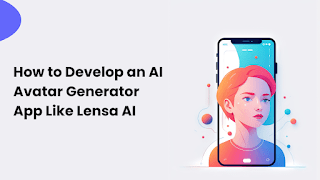How to Develop an AI Avatar Generator App Like Lensa AI?

Having an AI Avatar Generator App is now a popular and cutting-edge startup and development project. An AI Avatar Generator App uses advanced artificial intelligence and machine learning algorithms to transform user pictures into an original, individualized avatar using style-transfer neural networks. The avatars created by Avatars that are rendered by Lensa AI are highly realistic, artistic, or funny by tapping a few times, which has made these avatars popular to a point where they have opened up open-ended, thrilling creative possibilities in the realms of social media, gaming and avatar-like online presence.
If you want to develop a similar AI Avatar Generator App, it is important to know the underlying technologies, features, and development process. This blog will walk you through the major steps, from idea to launch, allowing you to develop an entertaining, user-friendly app that will be competitive in this increasing market.
An AI Avatar Generator App is an application for mobile or on the web that generates customized digital avatars through the power of artificial intelligence. Users upload images, but rather than relying on the images of their hand-drawn avatars, the app reimagines/rewrites the images to be more artistic or stylistically rendered.
These apps use deep learning models (such as Generative Adversarial Networks (GANs) and diffusion models) to learn facial features, artistic filters, and define personal avatars. AI apps are different from other editing software since they can process several styles fast and provide highly personalized results.
The best part about this AI Avatar Generator App is how fast and innovative it is. It’s super easy to use, especially if you don’t know much about graphic design, so you can easily create avatars for your gaming profiles, social media, or online personas.
Core Features of an AI Avatar App
An AI Avatar Generator App is unique due to its intelligent capabilities and artistic potential. The capabilities simplify the process of converting photos to avatars without compromising security and convenience. The following are the essential features that make a strong app in this category.
1. Image Upload and Preprocessing
The app enables the upload of photos directly from the device. Through preprocessing, images become rich; they are cropped and optimized before being used by AI models. This facilitates the accuracy of identification of the facial features and expressions so that accuracy can be achieved through the app.
2. AI-Powered Style Transformation
At the core of an AI Avatar Generator App is its transformation engine. It uses deep learning and neural networks to change faces and produces results in genres such as anime, painting, comic book style or photorealistic avatars. The technology develops according to trends and offers new designs to ensure that the users remain interested.
3. Personalised Avatars and Filters
Nowadays, users get pulled towards personalization. Most of these apps come with a collection of filters, accessories and personalization tools. You can create personalized avatars that show off your unique style, from clothing and hair choices to special backgrounds that reflect your character and personal brand.
4. Privacy and Data Protection Features
Because the app deals with user photos, security is key. Good encryption, keeping data anonymous, and easy-to-understand terms of service all go a long way in earning user trust. Some apps even let you scrub your pics from their servers once they’re done with them.
5. Convenient Sharing Options
Having easy access to social media platforms makes it simple for users to share their avatars. Whether an instagram page, gaming accounts, or business branding, the simple export and share functionalities all add further value for the user.
In summary, those four areas of AI avatar apps are pretty fun and practical. They showcase the latest AI, make it useful and provide a safe, creative, and incredibly fun experience.
Technology Stack to Build an AI Avatar Generator App
When building a scalable, secure, and optimized AI Avatar Generator App, choosing the right technology stack aka tech stack is important. The stack usually includes AI frameworks, backend and frontend technologies, and cloud integrations.
1. AI Frameworks and Libraries
The deep learning architectures that enable style transformations in the app include popular frameworks for training and deploying AI models like TensorFlow, PyTorch, and Keras. We can also use pre-trained facial recognition and image transformation models to speed up development. OpenCV and GAN-based architectures are other common choices for enhancing images.
2. Back-end and Front-end Technology
The backend takes care of user requests and AI stuff, all happening in the background. For the backend, I’d suggest Node.js, Python (with Django or Flask), or Ruby on Rails. The frontend would be a a nice, easy-to-use, and user-friendly interface. Still, we can recommend Facebook’s React Native or Flutter—as in Flutter’s case, it will be ‘native’ to both iOS and Android, or Swift. All these technologies combined provide a responsive design and smooth interaction.
3. Cloud Storage and APIs
Images and avatars typically come in large file sizes; cloud shows its dominance here. Services like AWS S3, Google Cloud Storage, or Azure are ideal choices as they are reliable and scalable. APIs are utilized for real-time image processing and other third-party authentication processes, as well as the integration of social media. CDNs are making things faster and easier for global access.
If you hire AI developers, it will help you build an AI Avatar Generator App using a solid application of AI frameworks, trustworthy backend/frontend technologies/tools, and reliable cloud services, which will return stunning results, delight users, and be scalable.
Step-by-Step Development Plan
The development of the AI Avatar Generator App should have a step-by-step process to ensure functionality, scalability, and user satisfaction.
1. Market Research and Competitor Research
Before moving forward to development, you need to perform thorough market research. This will enable you to see what people want and to look at existing apps that are competing with yours. This identifies gaps, trending features and opportunities to innovate. The results of the research inform your value proposition.
2. Defining App Features and Scope
After market research is complete, you can look at the core functions of the app, e.g. AI-based style effects and avatar customization, privacy settings, sharing options etc. Greater clarity and detail in defining scope helps the development team to stay aligned while operating within their purpose and the user’s needs.
3. Creating the AI Model
The AI model defines the bowels of the application. Developers incorporate the volume, such as TensorFlow or PyTorch, and feed it image sets to train in the style transfer and facial recognition. Optimization of the blending model enhances the results of the model to produce realistic avatars and not break down in performance.
4. App Design and UI/UX Development
A user-friendly and visually pleasing interface is a must. The designers focus on easy navigation of fluid, easy upload of images, and the accessibility of filters to bolt onto an avatar. Some applications utilized by the UX specialists in order to achieve engagement stimulation and accessibility include Figma and Sketch.
5. Performance Optimization and Testing
Apart from launch, all tests are done to ensure accuracy, performance, and security. Functional testing ensures that basic functions are supported, and stress testing is to check the scale of heavy traffic. Continuous optimization keeps the app fast and the clarity is not compromised
6. Deployment and Launch
After testing the app, a successful prototype, the app is deployed to a few platforms such as iOS, Android, or the web. Cloud infrastructure and API integrations facilitate smooth operation. And most companies also collaborate with an established and experienced AI app development company in order to have an easy rollout and go-to-market strategy. A rollout focused on app store optimization and marketing campaigns helps to promote visibility and a higher rate of adoption.
Implementing this step-by-step procedure, companies can develop a competitive and scalable AI Avatar Generator App that will be user-oriented and appear in the market.
Cost of Developing an AI Avatar Generator App
The overall cost of developing an AI Avatar Generator App will vary based on the complexity of the application, AI frameworks and design, as well as the decision regarding the platform(s). More advanced capabilities, including AI-driven style transfer, customisable avatars and rendering on command, contribute to that price.
It is also believed that the AI model is one of the biggest contributors. Fine-tuning and training need quality datasets and good computing power. The costs on backend systems, cloud storage and third-party image editing APIs are other features that contribute to the expenses. Partnering with a leading AI development company means that you get to cut down on costs but not on performance.
A basic AI avatar application may be as high as between $25,000 and $40,000.
A customized version with special filters, customisation and robust privacy settings will cost between $60,000 and over $120,000.
Over-spending can involve updates of apps, upgrades of servers and promotions.
Having well-laid-out objectives and the right team, organizations can choose an excellent AI Avatar Generator App that would strike the balance between its quality and cost.
Future Trends in AI Avatar Apps
The apps of I avatars are evolving rapidly; however, the future holds even more revolutionary potential. As the AI progresses, avatars will be even more sophisticated, realistic and apt to our digital presence. Companies that invest in an AI Avatar Generator App will get ahead in harnessing such innovation.
1. Hyper-Realistic 3D Avatars
Next-generation customizable AI avatar apps will soon create super-realistic 3D avatars that shape-shift like people, can express human expressions and gestures and can even express human emotions electronically. They will be deployed into gaming, metaverse experiences, and business meetings, creating interactive and engaging digital experiences.
2. Real-Time Multilingual Communication
The avatars will offer natural multilingual real-time translation with lip-sync very shortly.This will allow people to make conversation without any difficulty across languages and avatars are going to be most useful in international businesses, online learning and customer care.
3. Emotionally Intelligent Avatars
Future avatars will detect and react to user emotions in real time. The emotional intelligence of these avatars will make interactions more personalized and thus applicable in therapy, virtual companionship, and mental wellness apps.
4. Integration with Wearable Tech
AR glasses, VR headsets, and smart wearables will come to use an AI avatar app. This will result in very interactive experiences whereby avatars can be used as personal guides in the virtual and real world, fitness coaches, or personal assistants.
5. Custom content creation avatars
Avatars will create customized video content, commercials, and learning tutorials. If an organization can recruit AI developers, they will be able to create avatars to distribute branded content at scale, generating reduced production costs and increasing audience engagement.
Conclusion
AI Avatar Generator Apps are changing the way people represent themselves in cyberspace. From ultra-realistic avatars to emotionally intelligent companions, this all sounds bright and pleasant in the future of not only individuals but also organizations. The right combination of AI capability, creativity and security will be critical to creating an application like this. The cooperation with a Generative AI development company can help you make an idea come true and get a bonus in a crowded market. With the right deep AI architectures and user-centered design principles, companies can widen their horizons through social media, gaming, branding, and the metaverse.

Source: How to Develop an AI Avatar Generator App Like Lensa AI?




